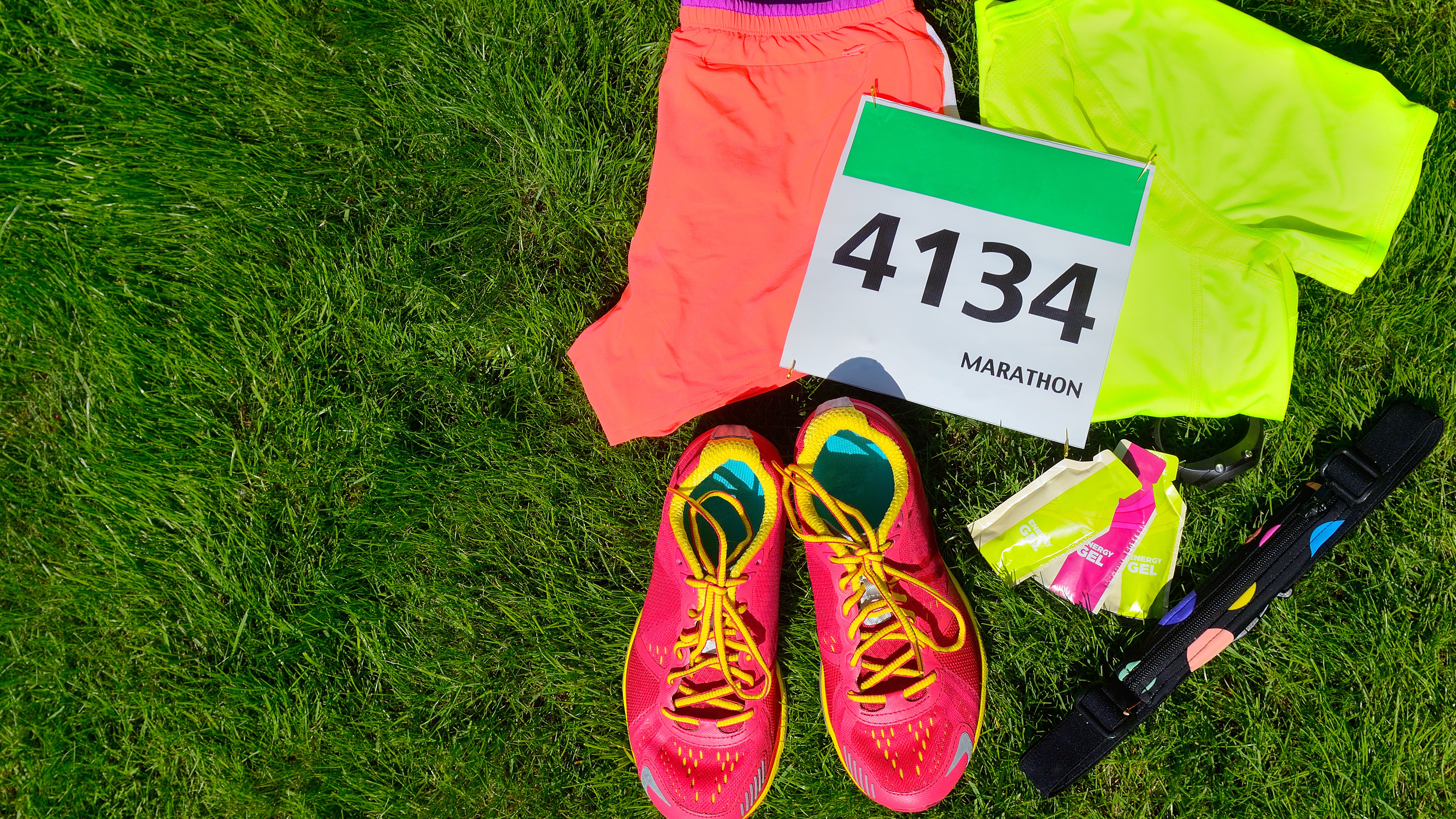
Are you signed up for your first running race this year? If so, you might be wondering what to do next. Many of us register for a 10k or half marathon in the hopes that doing so will simply motivate (or pressure) us to get to the finish line, and sometimes, it does. But let’s face it, Forrest Gump was just a movie. In real life, without proper preparation, you could wind up injured, unable to finish, or not even make it to the starting blocks, all of which would be really disappointing, to say the least.
Preparing for your first race requires careful planning, from training and getting the right kit to goal-setting and pre-race fuelling. Proper preparation ensures you’re physically ready for the race, have the energy to keep going and can overcome race day nerves, all of which will mean you have a more enjoyable race, and are likely to make it the first of many.
1. Set a goal
Once you’ve chosen a race and signed up, it can be smart to set an achievable goal. This can give you something to focus on during both your training and your race, and that can help you stay motivated, while achieving your goal can also give you a greater sense of satisfaction (for this reason, it’s a good idea to set a secondary goal in case you don’t make your primary goal.
Your goal could be something ambitious, like running a sub three-hour marathon, but it can easily be as simple as just finishing the race. When I did my first triathlon in 2012, I simply wanted to finish and I wanted to do so without walking during any of the running section. I didn’t finish anywhere near the podium, but I managed to achieve my goals and I was really happy with myself.

2. Make a training plan
For injury prevention, it’s obviously vital to make a smart training plan, and to leave yourself enough time before race day to actually execute it. There is no one way to train, and your plan will depend on where you’re starting and where you want to get to, but just as a rough idea, in our first marathon training plan we recommend 12 weeks for seasoned runners, but a full year for novices.
The most important aspect of training to remember is to build up gradually to give your body time to adapt to each increase in load, make ample room for rest and recovery and if possible, work with a coach and train in conditions similar to those you’ll be racing in.
3. Gear up
As you get closer to the big day, you’ll need to start to consider your gear. You’ll need to choose trail running shoes or road running shoes and have trained in them for a while to be sure they’re right for you. If you’ve already put in a ton of miles of them, you may need to replace them with an identical pair a few weeks before the race, and break them in. Once you’ve found the perfect pair of running socks, have a new or nearly new pair set aside for race day.
Use your training months to figure out what clothing you’re most comfortable in, taking into account the expected climate and conditions. Are you happiest in a pair of running shorts or do you prefer running tights? You’ll need a well-fitting running top that’s breathable and doesn’t chafe, and consider whether you want to run with a headband or running hat if you're expecting sunny conditions.
Remember, the general rule for running is light, breathable clothing that wicks moisture, but everyone is different. Reigning UTMB champ Courtney Dauwalter is well-known for running in baggy men’s running shorts and shorts, which isn’t common, but it definitely works for her.

4. Rest up
You’ll spend months slowly ramping up your mileage in order to reach your race distance, but once you get there, you’ll want to start to reduce both your distance and intensity in the final couple of weeks before your race, a practice known as tapering. During this time, you’ll focus on easy runs.
In the final two days before your race, get complete rest and lots of sleep. If you’re not a great sleeper, read our article getting better sleep for some tips on improving your sleep hygiene and routine.
5. Recce your route
Ultra runner Renee McGregor has ranked highly in some pretty rugged races, from Snowdonia to the Himalayas, and when I heard her talk about her accomplishments, she described making the podium in a gnarly race where the majority of participants took a wrong turn. Her advantage? She wasn’t necessarily the fastest runner, but she had checked out the race course ahead of time and knew where to go.
Understanding your route before you take off, if possible, can help you plan for when you’re going to want to slow down, or walk, where you can gain back some time, when and if you’ll need running poles and any tricky sections in a trail race where there’s the possibility of getting off-route.
6. Get in the right headspace
In addition to your physical training, it’s advisable to give your mental state some attention. Running a race can be exhilarating and empowering but it can also be nerve wracking and daunting. In the months leading up to your race, it can be worthwhile practicing mindfulness or meditation, which a 2020 study published in the journal Neural Plasticity found improved coordination, endurance and cognitive function. This could help you in the lead up to the race and in combating race-day nerves.
Know yourself and understand what you’ll need the day before your race and morning of to ensure you’re in the best head space possible. It might be good to minimize social contact and give yourself some quiet time to focus and get in the right headspace.

7. Fuel up
Just like filling up the tank of your car before you set off on a long drive, you’re going to want to make sure your body has plenty of energy stored before a race. For a race that’s not likely to take much more than an hour, you can simply make sure you eat well in the couple of preceding days, but fueling for endurance races can take careful fine-tuning. Following his second-place win at the 2023 UTMB, Zach Miller revealed that for him, managing his sodium levels with salt tablets was the secret to success.
For longer distances, you might want to consider increasing your carbohydrate intake – a practice known as carb loading – to increase your body’s glycogen stores. The best nutritional advice is to focus on well-balanced meals with protein and carbohydrates and not going overboard on refined carbs or fiber, which might wreak havoc on your gut. Learn more in our article on carb loading.
Though you should definitely eat well in the days leading up to your race, if you’re going to be able to eat during the race and are loading your hydration vest up with running gels, then you don’t necessarily need to carb load, but you will want to make sure your stomach can handle gels and take them with plenty of water to avoid the dreaded “runners' trots.”
Ultimately, for longer endurance races, working with a dietician will give you an advantage, since every athlete and every race is different. This will help you avoid the pitfalls of low energy availability and might help you figure out your unique nutritional needs faster.

8. Pre-hydrate
As we explain in our article on hydration tips for runners, hydration for a race doesn’t begin with filling up your hydration pack. Your behavior in the days before a long run can really affect your hydration levels on the big day, so avoid dehydrating foods like caffeine and alcohol.
According to Susan Kitchen, registered dietitian and USA Triathlon Level II and IRONMAN certified endurance coach, if you’re training for a big race, you want to avoid being in the heat unnecessarily in the days leading up to it, unless you're just doing a training run, but sitting outside on the beach sweating, or in a sauna, is not a good idea. Sip plenty of water in the days before your race, too.
9. Make a recovery plan
Chances are, all of your energy and efforts will be focused on that finish line, but the longer the race, the more you’ll want to make a recovery plan, otherwise it’s all too easy to end up having too many celebratory beers, which after a long run can be a bad idea.
Try to plan for at least a couple of days off work following your race to recuperate, hydrate and nourish your body, schedule a massage and engage in some of your favorite recovery activities to reward your body for all its hard work.

10. Set your alarm
The night before race day, make sure you set your alarm nice and early so you have plenty of time to prepare. Chiefly, you’ll want to have time to sip water, eat and give yourself enough digestion time before the starting gun goes.
In our article on what to eat before a half marathon, we explain that nutrition experts recommend runners eat a familiar breakfast around three to four hours before the race start, or a large snack 90 minutes to two hours beforehand. When deciding what time to get up, factor in that meal as well as how much time you need to get to the race plus any other pre-race rituals you want to observe.







